This vegan pad thai post has been updated with historical information since its original publication date, and is in general one of my most frequently updated posts.
What's not to like about a good vegan pad thai? Just a head's up: mine is a lot different than most results you will find when you do a quick Google search for vegan pad thai recipe. The reason is most are based on saucy, sugar charged pad thai recipes served abroad. These versions, while enjoyable as a kind of Western-Thai fusion dish, diverge signigicantly from any version you would be served in Thailand. My vegan pad thai recipe is more akin to what you would find if you ordered this dish in its country of origin, both in terms of flavour and portion (more snack sized than mega meal).
As much as I avoid the word authentic in food discussion and the snobbishness (not to mention inaccuracy) it often suggests, here I mean its use to reference some ingredients that have somehow been forgotten in the exported version of this Thai favourite.
Since I'm a bit of a food anthro nerd, I'm also throwing in a brief history of how pad thai came to be as popular as it is today. Or you can skip straight to the recipe using the jump to links below.
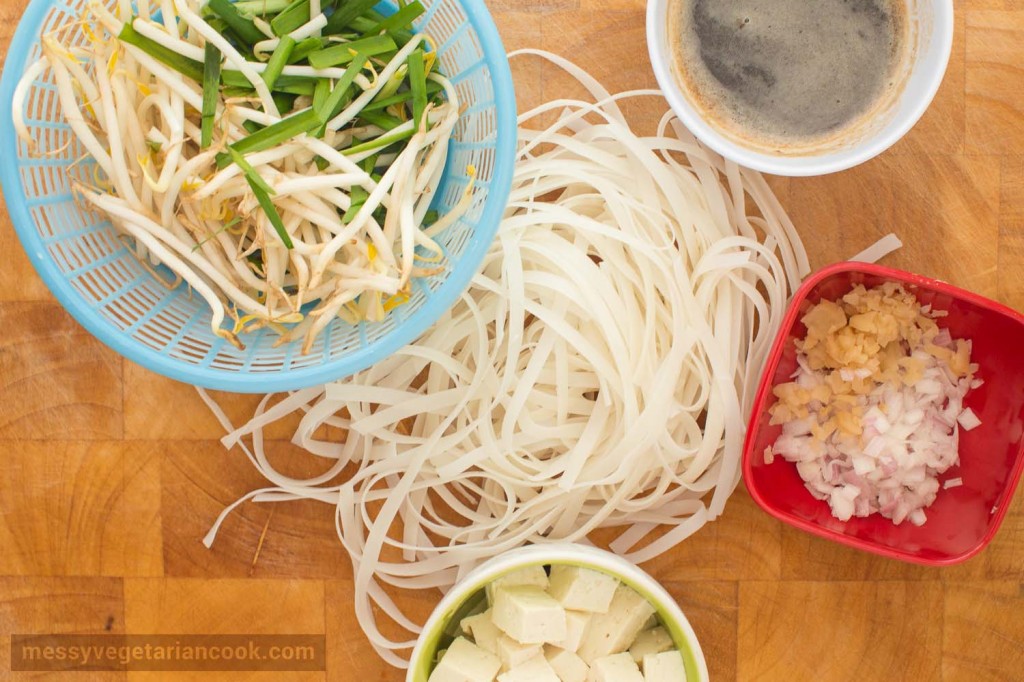
🇹🇭 A brief history of pad thai
Of the numerous pad thai origin stories perhaps the most popular is one of Thai unity, where the noodles were the result of a need to both reduce domestic rice consumption (rice noodles use less rice to feed a population) and to promote Thai identity at home and abroad. Sometimes included in the narrative is a contest held to create this uniquely Thai dish. Others maintain pad thai originated from the kitchen of the prime minister who was in power at the time, Plaek Phibunsonkhram (often referred to as Phibun).
Many historians today think the dish originated from the funeral souvenir book (a Thai tradition to preserve memories of the departed) of a member of the royal family who died in 1942. Assuming this is true, there is still a story to be told of how pad thai came to be popularised.
The most historically backed narrative seems to follow the idea of producing rice noodles as a cheaper alternative to steamed whole grain rice, but there is more to the story. Researching and trying to land on a believable master narrative for how pad thai came to be widely known shepherded me into the labyrinthine tangle of history and politics that is Thai rice economics. I will touch on that only lightly in discussing the role consummate nationalism played in the creation of the dish.
Field marshal Plaek Phibunsongkhram
The story begins with Mussolini-inspired Plaek Phibunsongkhram, the United States backed prime minister associated with the rise of fascism in Thailand. Phibun spearheaded a nationalist movement that (among other things) led to the conception of the wok fried tamarind noodles we appreciate globally today.
Phibun had his first stint in power during the Second World War and is known for his program of ratthaniyom, which is a reference to nationalist state customs. His goal was a modernised, strong, and proud state in the image of nationalist philosophies rapidly gaining political currency in Europe, like fascist Italy and Nazi Germany. A means for rolling out these changes were Phibun’s 12 state decrees, or cultural mandates, which ordered a number of social adjustments. These included changing the country’s name from Siam to Thailand, denying regional identities by insisting on a homogenised and rigidly defined Thai identity, quashing minority languages, and pursuing a general push toward elevating the state above all else.
WWII, flooding, and sinophobia
Thailand took an economic hit around the war years due to both environmental and war factors.
Flooding around Thailand’s central plains (the rice growing region) in 1942 negatively impacted rice crop yields to the tune of a million tonnes lost. The rice shortages drove prices for the country’s food staple higher and rice became less accessible. The production of rice noodles for sustenance was hence justified for a couple of reasons. First, the noodles could be made more cheaply from poorer quality broken rice (which is unsuitable for steaming). Second, this meant Thailand could export a greater quantity of its good crop in a bid to improve their economic situation.
WWII, during which Thailand was allied with Japan (Phibun allowed Japan to occupy), also took an economic toll. During the war the Thai baht was backed by the Japanese yen, but with the defeat of axis powers came the collapse of the Japanese economy. Inevitably this left Thailand fiscally up the creek without a paddle. Further, Britain forced a war indemnity to the tune of 1.5 million tonnes of rice on Thailand as a war reparation (incidentally, what was left of these punitive requirements, which had been argued down anyway, was forgiven in 1948). Much like the floods, the indemnity also contributed to high domestic rice prices.
There is a third reason why, from a nationalist agenda of homogeneity and discrimination, rice noodles grew in popularity. In a rising nationalist movement in a country with a cuisine heavily influenced by Chinese migration, this was an opportunity to also bury and demonise non Thai food identities. Rice noodles, or kway teow in Chinese (and Thai) language, were already a firm staple on Thailand’s streets. At that time, street food vendors were predominantly Chinese immigrants serving various kway teow pad (pad see ew) dishes. The government under Phibun wished to obfuscate Chinese influence in favour of Thainess, and promoting pad thai was one way to do so. They even distributed zines with instructions on how to make the dish.
Kway teow pad thai, shortened now to pad thai, is what kickstarted Thai street food culture in Thailand.
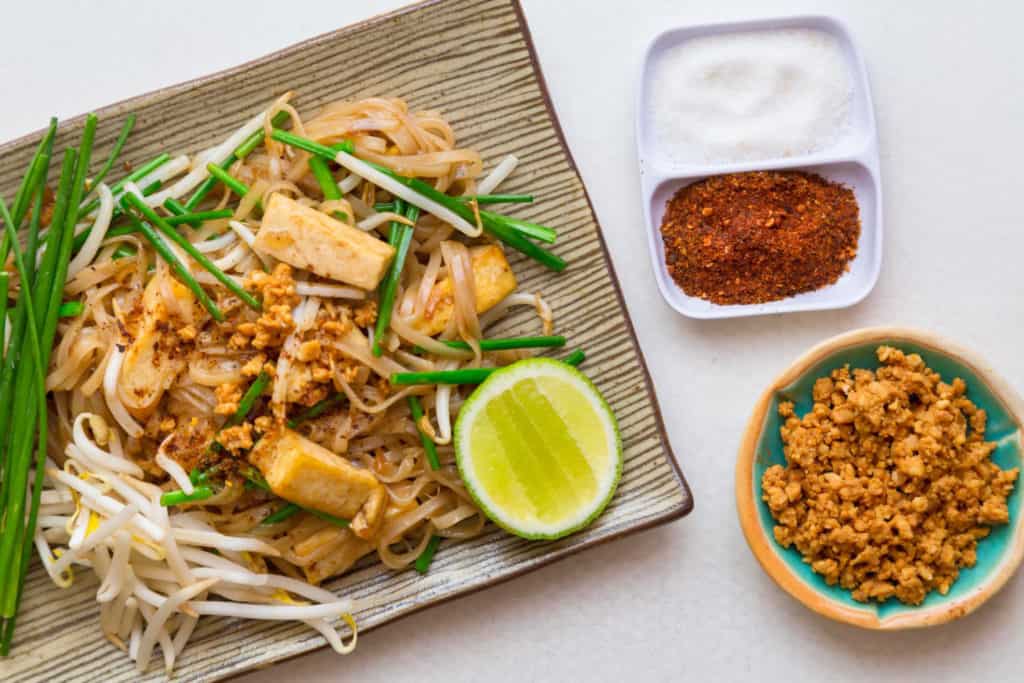
📝 Recipe notes
If your only experience with pad thai comes from dining in Thai eateries abroad, the ingredients in this recipe might seem sparse. That is, there aren’t heaps of stray mixed vegetables to pad out the noodles. There's no sriracha zigzagged across the top, no garnish of herbs.
There may be some unfamiliar ingredients in this preparation, which is more akin to what you will find in Thailand – Chinese chives and shredded preserved radish. I’m not sure why these ingredients have been omitted across most of the rest of the world as they are not particularly difficult to come by. If you can only find whole preserved radish pieces, cut them into a fine mince. Just make sure it's the sweet rather than the salty kind.
Spring onions can technically be substituted for the garlic chives but will not offer the same flavour profile. Both the chives and pickled turnip can be sourced at large (or maybe even small) East Asian grocers.
A tip for an extra firm and flavoursome tofu is to simmer cubes in salted water for fifteen minutes, then leave to drain and cool before using.
📖 Recipe
Authentic Vegan Pad Thai ผัดไทย
Equipment
- Wok
Ingredients
- 120 grams dried thin sen lek flat rice noodles 3mm is my favourite, soaked in room temperature water for one hour
- 2 tablespoons palm sugar
- 2 tablespoons plus 1 teaspoon thin soy sauce
- ¼ teaspoon salt
- 1 tablespoon tamarind pulp
- 3-4 tablespoons hot water
- ¼ cup vegetable oil
- 150 grams of the firmest tofu you can find cut into ¼-½ inch cubes
- 20 grams 2 heaped tablespoons finely diced shallot
- 15 grams 1 tablespoon shredded preserved radish/turnip the sweet kind, not the salty one
- Handful bean sprouts
- Handful chinese chives cut into 1 inch lengths
- 1-2 tablespoons roasted chopped peanuts
- Slices of fresh lime
- Roasted chilli powder optional garnish
Instructions
- Soak the rice noodles in warm water for one hour. Boiling them to cook aids in their demise, so don’t be tempted unless you’re okay with soggy noodles. If you are, no judgement because sometimes I like them too.
- Make tamarind water by mashing the tamarind pulp and 45 millilitres of hot water in a small bowl. Fork and/or hands will suffice. Use the back of a wooden spoon or silicone spatula to press the pulp against a mesh strainer, sieving the thick-ish liquid into another small bowl. Be sure to scrape the thick goop from the bottom of the strainer. Discard the solids left in the strainer. Mix the palm sugar, soy sauce, and salt into the tamarind water.
- Once the noodles are soaked (the consistency will be bouncy with a little firmness, and they won’t taste like they’re ready to eat yet), heat a wok to medium high heat. Once hot, add the oil.
- Stir fry the tofu, shallot, and preserved radish for a few minutes, just until the tofu begins to colour. Add the noodles and the tamarind sauce, continuing to stir fry for about a minute. If the noodles don’t soften a little under the heat, toss a tablespoon of water in to aid in softening.
- Add most of the bean sprouts and Chinese chives, stir-frying just until wilted.
- Dish up, garnishing the noodles with the remaining sprouts and chives, plus a sprinkling of peanuts and toasted chilli powder. Serve with a slice of lime.

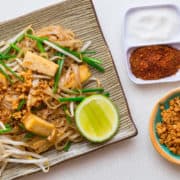
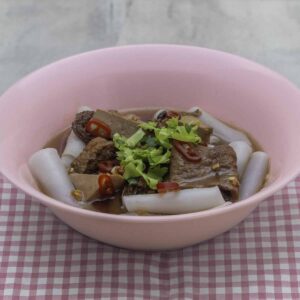
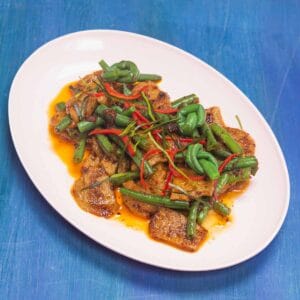
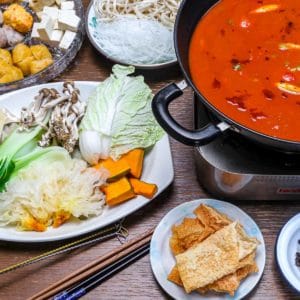
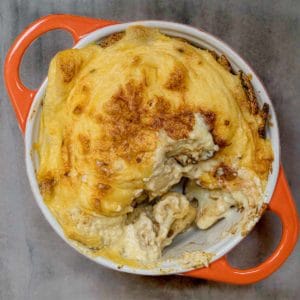
Caitlin says
What do you find most restaurants do to make it inauthentic? Is it the sauce that they don't do 'authentically' or the additional ingredients?
Kip says
I find the flavour to be an unbalanced salty pile of overcooked noodles. They almost always taste good, but are different nevertheless. My recipe isn't even perfect. Even Thais rarely make this dish at home since it's so plentiful on the streets, where it's made by third generation hawkers who can product this dish like nobody's business.
Also I like the condiments that are served alongside in Thailand because I love condiments (roasted chili powder, sugar, soy sauce, etc...)
Carla says
When exactly are you supposed to add the tamarind sauce? I added it after the noodles just to warm it through. I will say, my dish came out much darker than your pic or than I've normally had it. We did enjoy it and like the pickled radish in the dish. Thanks.
Kip says
Hi Carla,
Thanks for pointing out the error, which I've now corrected. The tamarind and noodles should go in at the same time, so the way you did it sounds rights. Pad Thai is, in my opinion, one of the more difficult Thai dishes to do well at home. You won't find many Thais who cook it, not when it is so readily available on the street by third generation pad thai hawkers!
Carla says
Thanks for that. I will say that I thought your version was much easier and faster and just as tasty as some of the others I've tried and since it is tough to find good Thai food here in Germany, I gotta take what I can get. ; p
Also, the tip about soaking the noodles in warm water as opposed to hot is a game changer! Never could figure out why mine were one big clump. I just discovered your site and am looking forward to trying some other recipes soon.
Kip says
It is tough to find good Thai food anywhere that isn't in Thailand, sadly. Glad you enjoyed the recipe and thanks again for pointing out my error.
Abhilash says
Hey. Can I substitute normal sugar for palm sugar since I can't find any?
Kip says
Sure, but try to use brown sugar if you have it to hand.
Pawel says
Great recipe!
Popular variations in Thailand is shredded carrot or few slices of shitake. Bit of Tua Nao and tofu crumbles seasoned with black salt is my own invention.
However, having fun reading this blog. Real Thai food and great explanation of techniques & ingredients.
Kip says
Tua nao is a fantastic idea! Can't wait to try that myself. Cheers for the kind words...
greta says
i never usually leave reviews or comments anywhere but i just tried this recipe and it was absolutely amazing! love your blog messy vegan 🙂 thanks for sharing so many inspiring and delicious recipes. i added about half the amount of sugar though and thought that was the perfect level of sweetness 😉
Kip says
aww thank you so much for taking the time to comment and let me know. I'm so pleased you enjoyed it 🙂
I reserve the right to improve malicious and trollish comments.